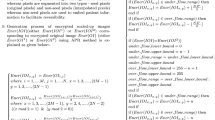Abstract
In the telemedicine industry, a standout among the most significant issue is the exchange of Electronic Patient Information (EPI) between patient and a doctor that are remotely connected. A minute change to EPI may result in a wrong diagnosis for the patient. To ensure secure and safe communication for telemedicine applications, a dual-image separable block-based reversible data hiding algorithm in encrypted domain for embedding secret message in base5 numeral framework is proposed here. The proposed scheme has not been suffering from underflow and overflow problem so that empowering it to embed and recover information precisely from low-intensity pixels too. This property makes our proposed methodology truly reasonable for its utilization on medical images. To prove the effectiveness of our proposed approach, experiments have been performed on different test images. The average PSNR value is 54.10 dB for an embedding capacity of 327,680 bits for all test images which demonstrates that the method is capable of giving good quality stego images even at high payload also. The experimental study revealed that for all types of test images, the proposed methodology altogether beaten all the compared methodologies in its ability to embed secret message and precisely recover it by maintaining the visual quality of stego images too.











Similar content being viewed by others
References
Abdulla AA (2019) Exploiting similarities between secret and cover images for improved embedding efficiency and security in digital steganography. Doctoral thesis University of Buckingham
Abdulla AA, Sellahewa H, Jassim SA (2020) Stego quality enhancement by message size reduction and fibonacci bit-plane mapping. arXiv:2004.12467
Bhalerao S, Ansari I A, Kumar A, Jain DK (2019) A reversible and multipurpose ecg data hiding technique for telemedicine applications. Pattern Recognit Lett 125:463–473
Bhardwaj R, Aggarwal A (2018) An improved block based joint reversible data hiding in encrypted images by symmetric cryptosystem. Pattern Recognition Letters 139(2020):60–68
Celik MU, Sharma G, Tekalp AM, Saber E (2005) Lossless generalized-lsb data embedding. IEEE Trans Image Process 14:253–13
Chen Y-C, Shiu C-W, Horng G (2014) Encrypted signal-based reversible data hiding with public key cryptosystem. J Visual Commun Image Represent 25:1164–1166
Chi L-P, Wu C-H, Chang H-P (2018) Reversible data hiding in dual stegano-image using an improved center folding strategy. Multimed Tools Appl 77:8785–18
Hong W, Chen T-S, Wu H-Y (2012) An improved reversible data hiding in encrypted images using side match. IEEE Signal Process Lett 19:199–3
Kim Y-S, Kang K, Lim D-W (2015) New reversible data hiding scheme for encrypted images using lattices. Appl Math Inform Sci 9:2627
Lee C-F, Huang Y-L (2013) Reversible data hiding scheme based on dual stegano-images using orientation combinations. Telecommun Syst 52:2237–10
Liao X, Shu C (2015) Reversible data hiding in encrypted images based on absolute mean difference of multiple neighboring pixels. J Visual Commun Image Represent 28:21–26
Lu T-C, Wu J-H, Huang C-C (2015) Dual-image-based reversible data hiding method using center folding strategy. Signal Process 115:195–18
Lu T-C, Chi L-P, Wu C-H, Chang H-P (2017) Reversible data hiding in dual stego-images using frequency-based encoding strategy. Multimed Tools Appl 76:23903–26
Ma K, Zhang W, Zhao X, Yu N, Li F (2013) Reversible data hiding in encrypted images by reserving room before encryption. IEEE Trans Inf Forensics Secur 8:553–559
Mansour RF, Abdelrahim EM (2019) An evolutionary computing enriched rs attack resilient medical image steganography model for telemedicine applications. Multidimens Syst Signal Process 30(2):791–814
Ni Z, Shi Y-Q, Ansari N, Su W (2006) Reversible data hiding. IEEE Trans Circ Syst Video Technol 16:354–358
Paillier P (1999) Public-key cryptosystems based on composite degree residuosity classes. In: International conference on the theory and applications of cryptographic techniques. Springer, pp 223–15
Parah SA, Ahad F, Sheikh JA, Bhat GM (2017) Hiding clinical information in medical images: a new high capacity and reversible data hiding technique. J Biomed Inform 66:214–230
Parah SA, Ahad F, Sheikh JA, Loan NA, Bhat GM (2017) A new reversible and high capacity data hiding technique for e-healthcare applications. Multimed Tools Appl 76(3):3943–3975
Puech W, Chaumont M, Strauss O (2008) A reversible data hiding method for encrypted images. In: Security, forensics, steganography, and watermarking of multimedia contents X, vol 6819. International Society for Optics and Photonics, p 68191E
Qian Z, Zhang X, Ren Y, Feng G (2016) Block cipher based separable reversible data hiding in encrypted images. Multimed Tools Appl 75:13749–17
Shi YQ (2004) Reversible data hiding. In: International workshop on digital watermarking. Springer, pp 1–12
Shiu HJ, Lin B-S, Huang C-H, Chiang P-Y, Lei C-L (2017) Preserving privacy of online digital physiological signals using blind and reversible steganography. Comput Methods Progr Biomed 151:159–170
Tai W-L, Chang Y-F (2018) Separable reversible data hiding in encrypted signals with public key cryptography. Symmetry 10:23
Tian J (2003) Reversible data embedding using a difference expansion. IEEE Trans Circ Syst Video Technol 13:890–896
Wu X, Sun W (2014) High-capacity reversible data hiding in encrypted images by prediction error. Signal Process 104:387–13
Xiao B, Ying L, Huang Y (2010) Reversible data hiding using histogram shifting in small blocks. In: 2010 IEEE International conference on communications (ICC). IEEE, pp 1–6
Yao H, Qin C, Tang Z, Tian Y (2017) Improved dual-image reversible data hiding method using the selection strategy of shiftable pixels’ coordinates with minimum distortion. Signal Process 135:26–29
Zhang X (2011) Reversible data hiding in encrypted image. IEEE Signal Process Lett 18:255–3
Author information
Authors and Affiliations
Corresponding author
Additional information
Publisher’s note
Springer Nature remains neutral with regard to jurisdictional claims in published maps and institutional affiliations.
Rights and permissions
About this article
Cite this article
Bhardwaj, R. An improved separable reversible patient data hiding algorithm for E-healthcare. Multimed Tools Appl 80, 26429–26449 (2021). https://doi.org/10.1007/s11042-020-10344-3
Received:
Revised:
Accepted:
Published:
Issue Date:
DOI: https://doi.org/10.1007/s11042-020-10344-3




